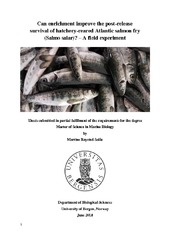Can enrichment improve the post-release survival of hatchery-reared Atlantic salmon fry (Salmo salar)? – A field experiment
Master thesis
Permanent lenke
https://hdl.handle.net/1956/18093Utgivelsesdato
2018-06-26Metadata
Vis full innførselSamlinger
Sammendrag
Release of captive-reared fish to supplement reduced, wild populations has become a common tool for conservation and management. Such attempted population enhancements have, however, had limited success, and several previous studies provide evidence that one of the main reasons could be high mortality of newly stocked fish. Conventional hatchery-rearing might generate traits and behavioral deficiencies disadvantageous for survival in the wild. Previous experimental studies report that enrichment during rearing promote a more flexible behavioral-repertoire and it has been suggested that enriched rearing could be a way to increase fish survival. Yet there is limited evidence of whether enriched rearing actually does have an effect on survival of released individuals in the wild. In the present field experiment I have investigated the immediate post-release predation mortality and survival two months after release of Atlantic salmon fry (Salmo salar) from two rearing treatments (distinguishable by alizarin marks in their otoliths). One group was reared in a structurally enriched environment and the other in a conventional, plain environment. Predation mortality was investigated by capturing predators and examining their stomach contents for fry. Survival was estimated from electrofishing by sampling the survivors in the river two months later. The predation mortality on the two groups just after release differed only for one of the experimental years, where 60% of the consumed fry were from the plain treatment. Equal numbers of fry from both treatments were recaptured two months later in all except one year, when 63% of the sampled fish originated from the plain treatment. The data also show that enriched rearing reduced the growth of the fish, and that predation was sizeselective towards small prey. These novel results suggest that enriched rearing possibly can provide salmon with an enhanced ability to hide from predators immediately after release, but that the enrichment might not be sufficient to promote enhanced survival beyond that. This will be discussed with consideration given to the potential, and limitations, of structural enrichment during rearing and the release procedure. Perhaps future research should take a more detailed look at the effects of different release practices on survival of captive-reared fish.
